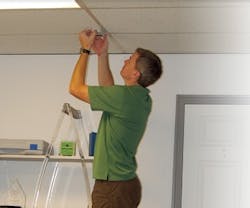A fleet of new building controls is harnessing ambient light to keep rooms at the perfect temperature, open and shut windows, and turn off lights in empty rooms.
The first generation of battery-free wireless controls like EnOcean’s harvest their own power by capturing the minute amounts of energy generated when a button is pressed. These tiny bursts of power are strong enough to transmit three one-millisecond wireless signals, or "telegrams."
A new solar light sensor that recently hit the market takes it a step further by harvesting and storing power from the ambient light in each room or the daylight coming through the window via miniature solar panels – enough to power the controls for three days or more when the lights are turned off. The panels allow them to harvest energy without mechanical action, unlike their predecessors, and the sensor turns off the lights if the room is too bright, allowing better usage of daylight.
These new sensors are manufactured by companies like Illumra, a Utah-based manufacturer and a member of the EnOcean Alliance. This group includes about 100 manufacturers who incorporate EnOcean’s basic technology into various building control products.
"You use less materials. You don’t need copper wire all over the place," explains Jim O’Callaghan, president of EnOcean’s North American branch. "The second benefit is that in many cases, people would like to upgrade their buildings, but they don’t necessarily want to take them out of service to allow a group of people to come in and start popping all the panels and running wires all over the place. They would like to be able to make changes without significant invasion of their business."
Controls Complement Wired Systems
None of the switches or sensors, solar or otherwise, require any wires between the switch or sensor and the device it controls. Companies promoting earth-friendly policies can appreciate the lowered demand for electricity and miles of copper wiring. Eliminating the need to knock holes in walls and add extra wires to the existing wired system can save about 30% on materials, not to mention time and labor costs, according to Illumra director Jan Finlinson.
A recent tenant improvement project proved the value of wireless technology to master electrician Steve Chapman of Reed Team Building Services, who thought his two-man crew would have to spend two or three days installing 35 occupancy sensors as part of a 38,000-square-foot tenant improvement project. Instead, the team finished in three hours, allowing them to quickly move on to the next phase.
"We were pretty surprised," Chapman says of his first time installing wireless, batteryless switches and sensors. "I love to install these. I don’t want to do it any other way."
By asking the right questions, a building manager can have basic wireless controls and switches built to the needs of the individual building – the sky’s the limit. For example, Illumra can use EnOcean’s discoveries to turn air conditioning off if a window is opened, turn down the heat or air conditioning in unoccupied rooms, or strike the perfect balance between wired lighting and natural light streaming in through a window.
Sensors Jump into Action at 2010 Olympics
At the 2010 Winter Games in Vancouver, BC, Illumra engineered a custom solution for the village housing the Olympic athletes. The manufacturer paired its occupancy sensor and LED dimmer with a light sensor that was built into the LED light poles lining a walkway.
"All of the street lights already had a light sensor, so they were coming on by themselves at dusk," Finlinson explains. "We provided an occupancy sensor that only allowed them to be on at 50% brightness level, which consumed 75% less energy than full brightness. Whenever anyone entered the path at any point, they would communicate wirelessly and the entire path would light up to full brightness."
For commercial building managers, the success at the Winter Games has many ramifications; namely, the importance of getting creative with requests and asking the manufacturer the right questions. The future of wireless controls depends on what customers want, need, and demand.
"There are probably eight to 10 different types of devices that can be powered by traditional low-cost indoor solar cells," O’Callaghan says. "So the solar industry itself is making great strides. For example, the solar is now starting to work at lower light levels, which is more important for indoor use. The efficiency is increasing – more energy for the same amount of light, and the cost is decreasing. All of those are positioning solar as a very viable alternative."
Janelle Penny ([email protected]) is associate editor of BUILDINGS.
About the Author
Janelle Penny
Editor-in-Chief at BUILDINGS
Janelle Penny has been with BUILDINGS since 2010. She is a two-time FOLIO: Eddie award winner who aims to deliver practical, actionable content for building owners and facilities professionals.

